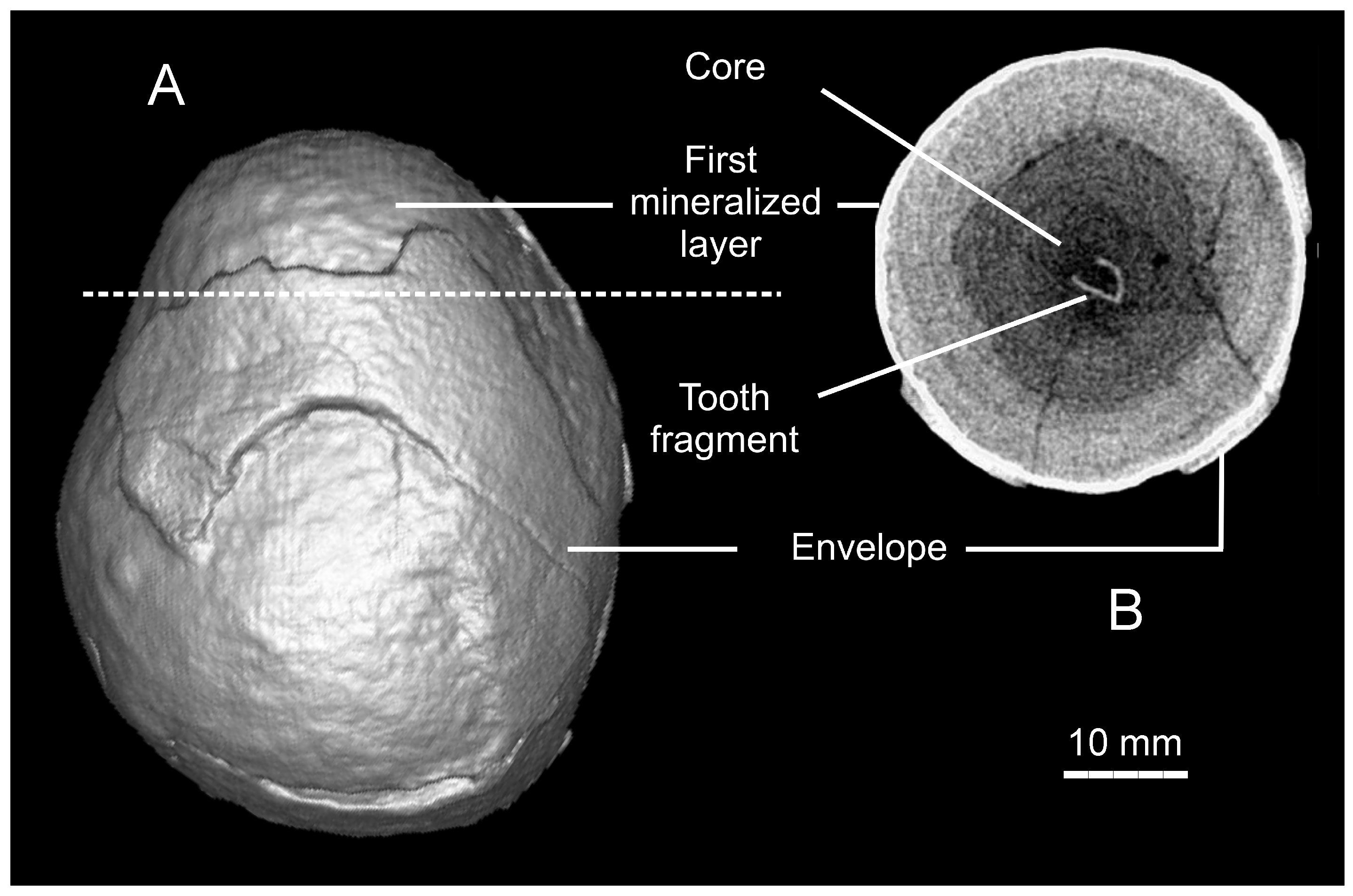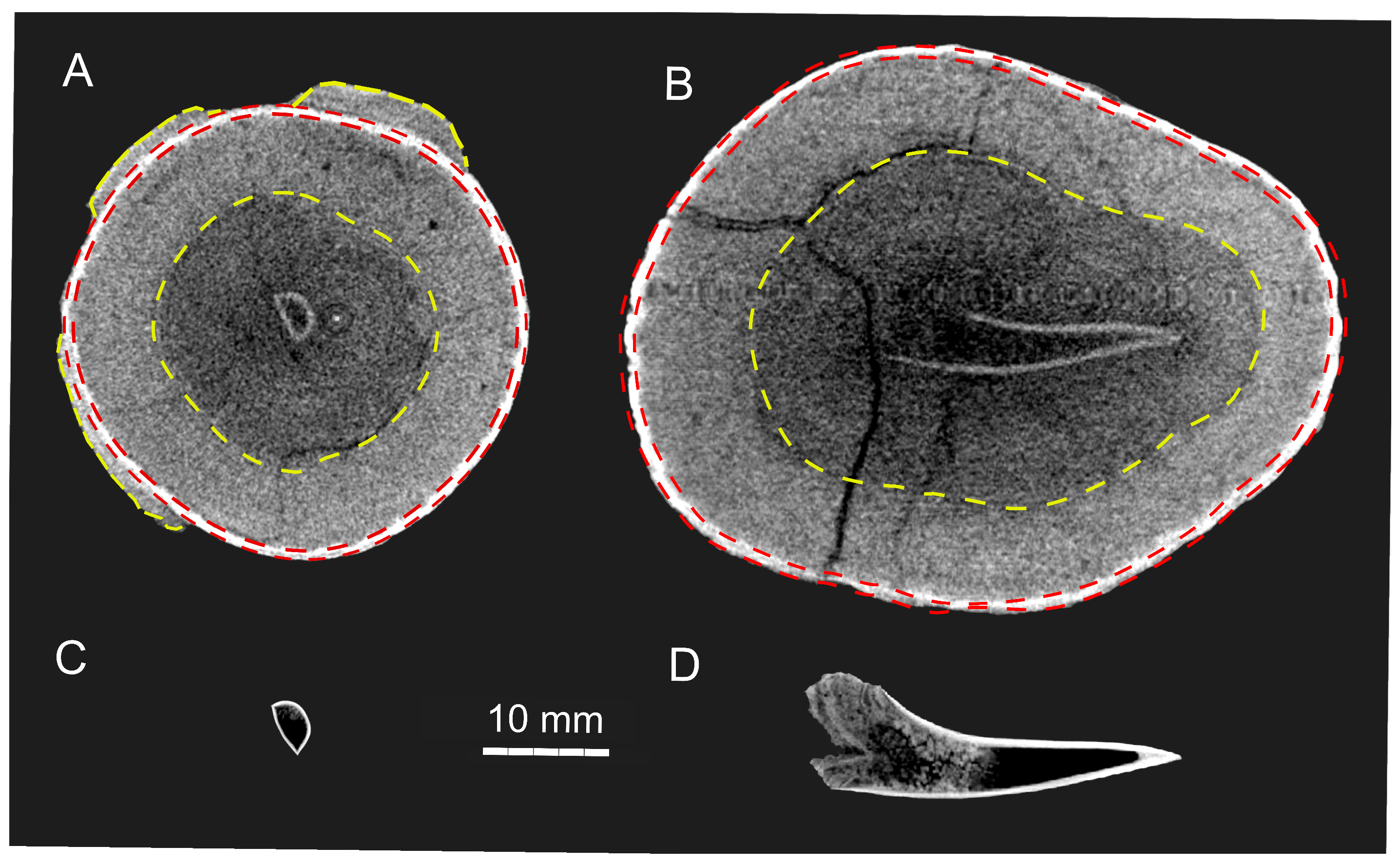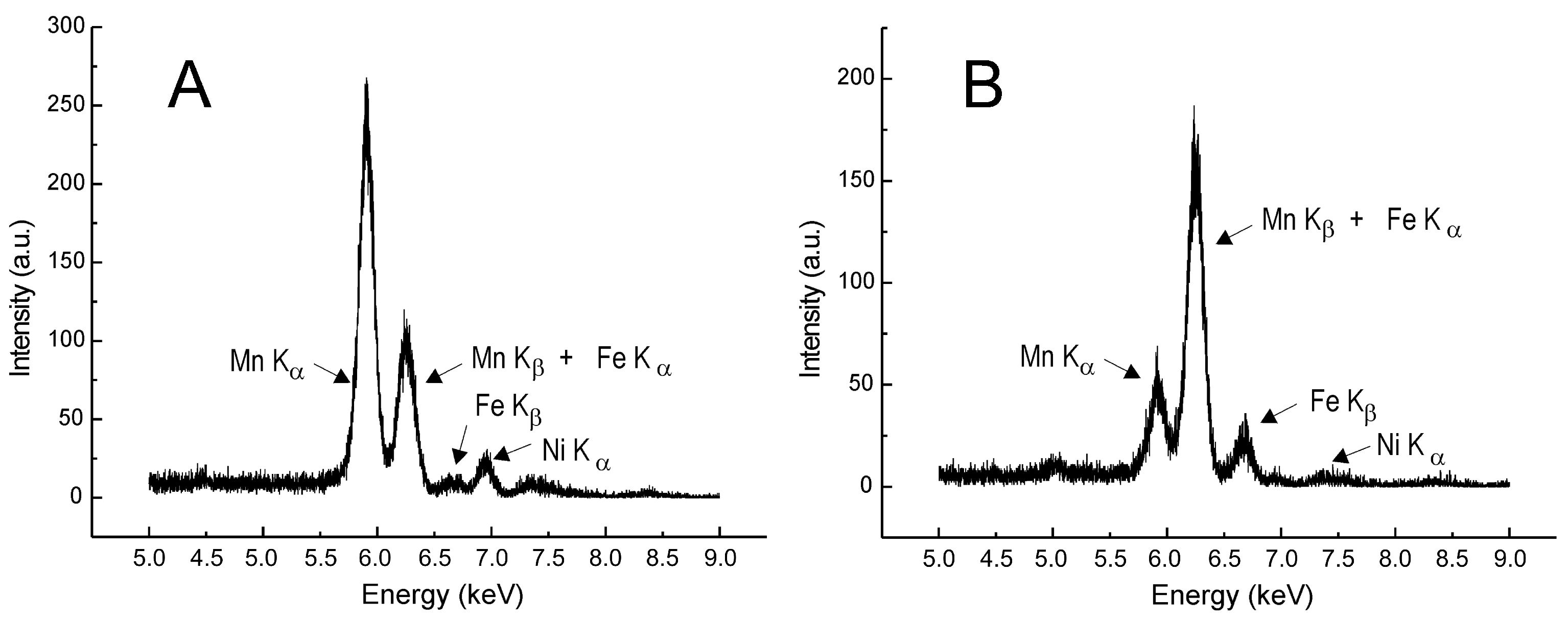Micro-Tomographic Investigation of a North-Western Pacific Polymetallic Nodule
Abstract
1. Introduction
2. Materials and Methods
2.1. Samples
2.1.1. Polymetallic Nodule
2.1.2. Shark Teeth for Identification
2.2. -Computed Tomography
2.3. XRF Measurements
3. Results and Discussion
3.1. Polymetallic Nodule and Shark Tooth
3.2. X-Ray Spectra and the Polymetallic Nodule Age
3.3. Nodule Layers
4. Conclusions
Author Contributions
Funding
Data Availability Statement
Acknowledgments
Conflicts of Interest
Abbreviations
| CT | Computed Tomograph |
| CAT | Computed Axial Tomography |
| ICP-AE | Inductively Coupled Plasma Atomic Emission |
| ICP-MS | Inductively Coupled Plasma Mass Spectrometry |
| LAC | Linear Attenuation Coefficient |
| LA-ICP-TOFMS | Laser Ablation Inductively Coupled Plasma Time of Flight Mass Spectrometry |
| CT | Micro-Computed Tomography |
| PN | Polymetallic Nodule |
| XRF | X-Ray Fluorescence |
| Z | Atomic Number |
References
- Stock, R.S. MicroComputed Tomography: Methodology and Applications; CRC Press: Boca Raton, FL, USA, 2019; ISBN 978-0429186745. [Google Scholar]
- Feldkamp, L.A.; Davis, L.C.; Kress, J.W. Practical cone-beam algorithm. J. Opt. Soc. Amer. A 1984, 1, 612–619. [Google Scholar] [CrossRef]
- Van Geet, M.; Swennen, R.; Wevers, M. Towards 3-D petrography: Application of microfocus computer tomographyin geological science. Comput. Geosci. 2001, 27, 1091–1099. [Google Scholar] [CrossRef]
- Ou, X.; Chen, X.; Xu, X.; Xie, L.; Chen, X.; Hong, Z.; Bai, H.; Liu, X.; Chen, Q.; Li, L.; et al. Recent Development in X-Ray Imaging Technology: Future and Challenges. Research 2021, 2021, 9892152. [Google Scholar] [CrossRef] [PubMed]
- Hounsfield, G.N. A Method and an Apparatus for Examination of a Body by Radiation Such as X-or Gamma Radiation. British Patent No. 1283915, August 1968. [Google Scholar]
- Guntoro, P.I.; Ghorbani, Y.; Pierre-Henri Koch, P.-Y.; Jan Rosenkranz, J. X-ray Microcomputed Tomography (μCT) for Mineral Characterization: A Review of Data Analysis Methods. Minerals 2019, 9, 183. [Google Scholar] [CrossRef]
- Duliu, O.G. Computer axial tomography in geosciences: An overview. Earth-Sci. Rev. 1999, 48, 265–281. [Google Scholar] [CrossRef]
- Ketcham, R.A.; Carlson, W.D. Acquisition, optimization and interpretation of X-ray computed tomographic imagery: Applications to the geosciences. Comput. Geosci. 2001, 27, 381–400. [Google Scholar] [CrossRef]
- Alves, H.; Lima, I.; de Assis, J.T.; Nevesc, A.A.; Lopes, R.T. Mineralogy evaluation and segmentation using dual-energy microtomography. X Ray Spectr. 2014, 44, 99–104. [Google Scholar] [CrossRef]
- Duliu, O.G.; Ivankina, T.I.; Herman, E.; Ricman, C.; Tiseanu, I. Orientation distribution function of biotite platelets based on optical, thin sections and m-CT image analysis in an Outokumpu (Finland) biotite gneiss: Comparison with neutron diffraction texture analysis. Rus. J. Earth Sci. 2016, 16, ES3003. [Google Scholar] [CrossRef][Green Version]
- Cornard, P.H.; Degenhart, G.; Tropper, P.; Moernaut, J.; Strasser, M. Application of micro-CT to resolve textural properties and assess primary sedimentary structures of deep-marine sandstones. Deposit. Rec. 2024, 10, 559–580. [Google Scholar] [CrossRef]
- Giamas, V.; Koutsovitis, P.; Sideris, A.; Turberg, P.; Grammatikopoulos, T.A.; Petrunisa, P.; Giannakopoulou, P.P.; Koukouzas, N.; Hatzipanagiotou, K. Effectiveness of X-ray micro-CT applications upon mafic and ultramafisc ophiolitic rocks. Micron 2022, 158, 103229. [Google Scholar] [CrossRef]
- Peris, D.; Mähler, B.; Kolibáč, J. Review of the family Thanerocleridae (Coleoptera: Cleroidea) and the description of Thanerosus gen. nov. from cretaceous amber using micro-CT Scanning. Insects 2022, 13, 438. [Google Scholar] [CrossRef]
- Heřmanová, Z.; Bruthansová, J.; Holcová, K.; Mikuláš, R.; Veselská, M.K.; Kočí, T.; Dudák, J.; Vohník, M. Benefits and limits of x-ray micro-computed tomography for visualization of colonization and bioerosion of shelled organism. Palaeont. Electron. 2020, 23, a23. [Google Scholar] [CrossRef]
- Bicknell, R.D.C.; Smith, P.M.; Birch, S.A.; Bevitt, J.J. An earliest Triassic age for Tasmaniolimulus and comments on synchrotron tomography of Gondwanan horseshoe crabs. PeerJ 2022, 10, 13326. [Google Scholar] [CrossRef] [PubMed]
- Xu, W.-J.; Sun, Z.-Y.; Liu, S.; Ji, C.; Lu, H.; Ma, Z.-L.; Wu, F.-Y.; Chen, S.-M.; Huang, J.-D. Multielement conodont apparatus (Cornudina) from the Lower Triassic of China, revealed by high-resolution X-ray microtomography. Palaeoworld 2025, 34, 200964. [Google Scholar] [CrossRef]
- Kuhn, T.; Wegorzewski, A.; Rühlemann, C.; Vink, A. Composition, Formation, and Occurrence of Polymetallic Nodules. In Deep Sea Mining; Sharma, R., Ed.; Springer: Berlin/Heidelberg, Germany, 2017; pp. 23–63. [Google Scholar] [CrossRef]
- Rizescu, C.T.; Georgescu, G.N.; Duliu, O.G.; Szobotka, S.A. 3-D dual gamma-ray computer axial tomography investigation of polymetallic nodules. Deep Sea Res. Part I Ocean. Res. Pap. 2001, 48, 2529–2540. [Google Scholar] [CrossRef]
- González, F.J.; Somoza, L.; Lunar, R.; Martínez-Frías, J.; Martín Rubí, J.A.; Torres, T.; Ortiz, J.E.; Díaz del Río, V.; Pinheiro, L.M.; Magalhães, V.H. Hydrocarbon-Derived Ferromanganese Nodules in Carbonate-Mud Mounds from the Gulf of Cadiz: Mud-Breccia Sediments and Clasts as Nucleation Sites. Mar. Geol. 2009, 261, 64–81. [Google Scholar] [CrossRef]
- Terauchi, D.; Shimomura, R.; Machida, S.; Yasukawa, K.; Nakamura, K.; Kato, Y. X-ray Computed Tomography Analysis of Ferromanganese Nodule Nuclei from the Western North Pacific Ocean: Insights into Their Origins. Minerals 2023, 13, 710. [Google Scholar] [CrossRef]
- Nakamura, K.; Terauchi, D.; Shimomura, R.; Machida, S.; Yasukawa, K.; Fujinaga, K.; Kato, Y. Three-Dimensional Structural Analysis of Ferromanganese Nodules from the Western North Pacific Ocean Using X-ray Computed Tomography. Minerals 2021, 11, 1100. [Google Scholar] [CrossRef]
- Heye, D. Growth conditions of manganese nodules. Comparative studies of growth rate, magnetization, chemical composition and internal structure. Progr. Ocean. 1978, 7, 163–239. [Google Scholar] [CrossRef]
- Eisenhauer, A.; Gögen, K.; Pernicka, E.; Mangini, A. Climatic influences on the growth rates of Mn crusts during the Late Quaternary. Earth Planet. Sci. Let. 1992, 109, 25–36. [Google Scholar] [CrossRef]
- Bollhöfer, A.; Eisenhauer, A.; Frank, N.; Pech, D.; Mangini, A. Th- and U-isotopes in a Mn-nodule from the Peru Basin determined by alpha spectrometry and Thermal Ionisation mass spectrometry: Are manganese supply and growth related to climate? Geolog. Rund. 1996, 85, 577–585. [Google Scholar] [CrossRef]
- Verlaan, P.A.; Cronan, D.S. Origin and variability of resource-grade marine ferromanganese nodules and crusts in the Pacific Ocean: A review of biogeochemical and physical controls. Geochemistry 2022, 82, 125741. [Google Scholar] [CrossRef]
- Hein, J.; Kira, M. Deep-ocean polymetallic nodules and cobalt-rich ferromanganese crusts in the global ocean: New sources for critical metals. In The United Nations Convention on the Law of the Sea, Part XI, Regime and the International Seabed Authority: A Twenty-Five Year Journey; Ascencio-Herrera, A., Nordquist, M.H., Eds.; Brill Nijhof: Leyden, The Netherlands; Boston, MA, USA, 2022; pp. 177–179. [Google Scholar] [CrossRef]
- Geyh, M.; Schleiher, H. Absolute Age Determination: Physical and Chemical Dating Methods and Their Application; Springer: Berlin/Heidelberg, Germany, 2012; ISBN 978-3-642-74826-4. [Google Scholar]
- Wilcken, K.M.; Codilean, A.T.; Fülöp, R.-H.; Kotevski, S.; Rood, A.H.; Rood, D.H.; Seal, A.J.; Krista Simon, K. Technical note: Accelerator mass spectrometry of 10Be and 27Al at low nuclide concentrations. Geochronology 2022, 4, 339–352. [Google Scholar] [CrossRef]
- Krishnaswami, S.; Cochran, J.K. Uranium and thorium series nuclides in oriented ferromanganese nodules: Growth rates, turnover times and nuclide behavior. Earth Planet. Sci. Let. 1978, 40, 45–62. [Google Scholar] [CrossRef]
- Lyle, M. Estimation of growth ratio of ferromanganese nodules from chemical compositios: Implication for nodule formation processes. Geochim. Cosmochim. Acta 1982, 46, 2301–2306. [Google Scholar] [CrossRef]
- Duliu, O.G.; Alexe, V.; Moutte, J.; Szobotca, S.A. Major and trace elements distribution in abyssal clay, micronodules and manganese nodules from Clarion-Clipperton region (North East Pacific). Geo-Mar. Let. 2009, 29, 71–83. [Google Scholar] [CrossRef]
- Peng, J.; Li, D.; Hollings, P.; Fu, Y.; Sun, X. Visualization of critical metals in marine nodules by rapid and high-resolution LA-ICP-TOFMS mapping. Ore Geol. Rev. 2023, 154, 105342. [Google Scholar] [CrossRef]
- Xu, L.; Deng, Y.; Guan, Y.; Sun, X.; Li, D.; He, W.; Ren, Y.; Xiao, Z. Nano-Mineralogy and Mineralization of the Polymetallic Nodules from the Interbasin of Seamounts, the Western Pacific Ocean. Minerals 2024, 14, 47. [Google Scholar] [CrossRef]
- Calvert, S.E.; Cousens, B.L.; Soon, M.Y.S. An X-ray fluorescence spectrometric method for the determination of major and minor elements in ferromanganese nodules. Chem. Geol. 1985, 51, 9–18. [Google Scholar] [CrossRef]
- Chubarov, V.; Amosova, A.; Finkelshtein, A. X-ray fluorescence determination of major elements in ferromanganese nodules. X-Ray Spectr. 2020, 49, 615–621. [Google Scholar] [CrossRef]
- Li, J.; Jin, Y.; Wang, H.; Yang, K.; Zhu, Z.; Meng, X.; Li, X. In-situ analysis of polymetallic nodules from the clarion-Clipperton zone, Pacific Ocean: Implication for controlling on chemical composition variability. Front. Mar. Sci 2024, 11, 1489184. [Google Scholar] [CrossRef]
- Garrick, J.A.F. Revision of sharks of genus Isurus with a description of a new species (Galeoidea, Lamnidae). Proc. United States Natl. Mus. 1967, 118, 663–690. [Google Scholar] [CrossRef]
- Enax, J. Structure, composition, and mechanical properties of shark teeth. J. Struct. Biol. 2012, 178, 290–299. [Google Scholar] [CrossRef] [PubMed]
- Purdy, R.W. A Key to the Common Genera of Neogene Shark Teeth, National Museum of Natural History, Washington D.C. Revised February. 1990. Available online: https://siris-libraries.si.edu/ipac20/ipac.jsp?&profile=liball&source=~!silibraries&uri=full=3100001~!723383~!0#focus (accessed on 10 June 2025).
- Nelson, J.S. Fishes of the World; John Wiley & Sons: Hoboken, NJ, USA, 2009; ISBN 978-0-471-25031-9. [Google Scholar]




| Layer | Average Thickness | Mn | Fe | R | Age |
|---|---|---|---|---|---|
| Cortex | 1.5 | 25.8 ± 1.3 | 3.75 ± 0.2 | 29.8 ± 0.4 | 50.3 ± 0.9 |
| First layer | 0.65 | 15.1 ± 0.7 | 10.8 ± 0.6 | 2.5 ± 0.2 | 260 ± 20 |
Disclaimer/Publisher’s Note: The statements, opinions and data contained in all publications are solely those of the individual author(s) and contributor(s) and not of MDPI and/or the editor(s). MDPI and/or the editor(s) disclaim responsibility for any injury to people or property resulting from any ideas, methods, instructions or products referred to in the content. |
© 2025 by the authors. Licensee MDPI, Basel, Switzerland. This article is an open access article distributed under the terms and conditions of the Creative Commons Attribution (CC BY) license (https://creativecommons.org/licenses/by/4.0/).
Share and Cite
Craciunescu, T.; Duliu, O.G.; Tiseanu, I.; Szobotka, S.A. Micro-Tomographic Investigation of a North-Western Pacific Polymetallic Nodule. Quaternary 2025, 8, 56. https://doi.org/10.3390/quat8040056
Craciunescu T, Duliu OG, Tiseanu I, Szobotka SA. Micro-Tomographic Investigation of a North-Western Pacific Polymetallic Nodule. Quaternary. 2025; 8(4):56. https://doi.org/10.3390/quat8040056
Chicago/Turabian StyleCraciunescu, Teddy, Octavian G. Duliu, Ion Tiseanu, and Stefan A. Szobotka. 2025. "Micro-Tomographic Investigation of a North-Western Pacific Polymetallic Nodule" Quaternary 8, no. 4: 56. https://doi.org/10.3390/quat8040056
APA StyleCraciunescu, T., Duliu, O. G., Tiseanu, I., & Szobotka, S. A. (2025). Micro-Tomographic Investigation of a North-Western Pacific Polymetallic Nodule. Quaternary, 8(4), 56. https://doi.org/10.3390/quat8040056






